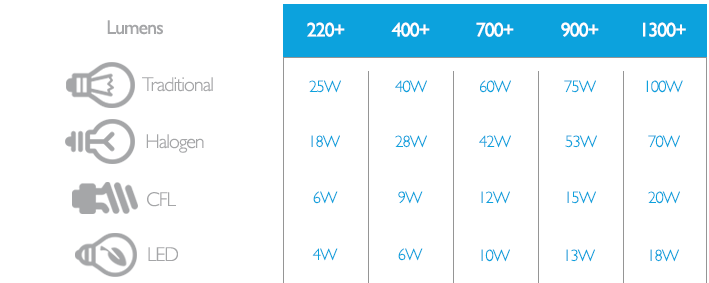By Michael Morrison on Tue 02 November 2021
Well... its all about watts and what they mean!
As part of our What’s the right bulb for the job series we are going to look at bulb wattages and what they mean and how the new LED bulbs translate to the older incandescent, halogen, and CFL bulbs.
Watts are the measurement of the power consumption that a bulb uses; the higher the wattage of the bulb the more light it is able to put out, but the more energy it uses. Well at least for the past several decades that was the case, however, these days with the more energy-efficient, low-wattage bulb types on the market this isn’t always the best way to compare your bulb.
Looking at an old halogen bulb, of which there are lots in use and we still stock plenty on the shelves for now, you would have been familiar with the likes of the wattage of about 50W for most office or general use. With a CFL (Compact Fluorescent Lamp) bulb this would come down to about 15W, which at the time was groundbreaking, and if you remember there was a big campaign to get everyone to switch to them, well these days technology has outdone itself even further.
If you were to take that old 50W bulb from before, the type used in many everyday applications, and you wanted to swap it out for the latest LED bulb, you would be looking at getting a 5W bulb, that’s right just 10% of the power used. As you can imagine those sorts of figures would have everyone smiling.
LED and how they compare to other bulbs
LED VS incandescent light bulbs
Halogen light bulbs are more efficient than traditional incandescent bulbs, but still require much more energy to generate light than LEDs, which use around 85% less energy than halogen bulbs.
LED VS CFL light bulbs
CFL (compact fluorescent lamp) light bulbs were the first real energy-efficient alternative to incandescent and halogen bulbs, using much less energy and lasting for much longer. LED light bulbs take energy efficiency to another level, using around 40% less energy than CFL equivalents.
LED VS Fluorescent Tube lights
LED T8 tube lights use between 40 and 50% less energy than fluorescent tube lights, which is of course comparable to CFLs that utilise the same technology.
LED equivalents to metal halide lighting
LED equivalents to metal halide lighting offer similar energy savings as above, around 50%
Quick reference guide for Lumens VS Watts
So with all this information now at hand, you can see how a single 5W LED bulb vs a 50W halogen bulb over the course of an LED bulb’s average lifetime is incredible. Before we even factor in that it would take roughly 20x halogen bulbs to cover the same time frame.
So not only are we saving money in both the long term and the short term but with the higher efficiencies, we are also saving the planet and being more sustainable, something that if it’s not already will be on everyone’s radar soon enough. Another added bonus is that since the LED bulbs are not using as much energy and are more efficient with the energy they use, they also generate much lower levels of heat than their equivalent halogen bulb meaning they are less likely to burn up and cause any damage.
In fact, this lower energy usage and lower heat generation help an LED bulb last much longer than your older style halogen bulb. In general, you are talking anything from 10-25x longer than halogen. We look more into this more in our Lifespan post.
If you or one of your clients are looking to make the switch to LED bulbs, why not give us here at Lamp Source a call and tap into our years of knowledge and expertise to make sure you are getting the right lamp for the application. It also helps that we have some of the keenest prices on the market.

